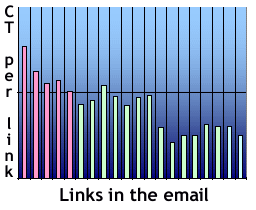Secret #6: Track Your Results
Respect the four magic TLAs (Three Letter Acronyms)
If
I ask you to, "Go from here to there," you won't be able
to do it unless you know where "here" and
"there" are. Knowing whether your email campaign worked is
exactly the same. You need to know where you're starting from, track
what happens when you email, and gauge where you end up in order to know
whether you were successful, or failed. For every campaign, I always
track these Four Magic TLAs:
1. CTR: Click-Through Rate.
CTR is calculated as the percentage of people who respond to your
email by clicking though to your site. This is the first gauge of
whether your campaign lives or dies. You must measure both the
overall response to your mailing and also look at sub-sets of data,
list-by-list and link-by-link in your email letter. I give
each link in the letter a unique URL and track every unique click
through a mail server. I want to know which part of the email
attracted the most response. I will frequently test multiple offers
or upsells this way to quickly determine the best mix of offer,
creative and list for any campaign. One factor I never waste time
with is "Open Rate". It's a useless, misleading and entirely
unrealistic email campaign performance gauge. Don't ever fall for it
as a success measure and don't even bother tracking it. Many
tracking systems count an email as allegedly opened, when all that
really happened is the recipient's email client had the preview pane
open and the email flashed for a split second on its way to the
deleted folder. No one really saw it in that case.
2. CTB: Click-to-Buy. CTB
is calculated
as the percentage of people who convert to customers from among
those who clicked through to your site. This is the all-important
revenue gauge. It requires accurate tracking of clicks from the
email to actual sales at the website. I also look at CTB over time.
I can conclude from the time study whether an email campaign had an
overall influence on sales. People often investigate on the first
few visits before they finally purchase. After the initial visit,
most returns come directly to your website and not through the email
link. Therefore, it would adversely skew the effectiveness analysis of
the email campaign if you don't take that behavior into account.
3. AOV: Average Order
Value. AOV is calculated as the amount customers buy on
their average order with each visit to your site. This gauge
measures whether the customers you're acquiring are spending
appropriately, or just grabbing your free offer and running. Current
customers usually produce the highest AOV. First time buyers
typically purchase less. The Internet industry average first-time
purchase is $25 or less. What I want to see is whether newly
acquired customers ramp up to higher AOV quickly and maintain that
level every time I email them. This gauge is an important measure of
list atrophy, website selling power and much more.
4. LCV: Lifetime Customer
Value. LCV is calculated as the product of AOV over time. This
gauge tells you whether customers are loyal and how often they
return for repeat purchases. It also sets a value on customer
acquisition that is fundamental to email campaign budgeting and
build pro forma (before the fact) revenue models.
But wait, there's more
The chart below shows you a winning long copy test
that was tracked by click-through on each separate link in the
email. It has the characteristic "triple-hump" response
curve that I typically see in my long copy emails. The important
thing to notice is that over 25% of the response came through AFTER
the first five email links. Most inexperienced email marketers, who
don't appreciate the power of long copy, stop short after just one or
two links. If this campaign had followed that common wisdom, it would
have thrown away a large portion of its potential response. As it was, the
mailing pulled in a 20% click-through rate, 18% click-to-buy ratio
and generated average order values in excess of $60.
 The
pink bars show The Hot Zone where most of the response comes
in. The green bars show The Pick-up Zone where we picked up
an additional 25% of the response. The blue bars show The End
Zone where I usually put links to an additional offer sweetener
that was promised early in the copy. I can gauge the strength of an
offer by the ratio between The Hot Zone and End Zone offer
links. So, long copy costs not one penny more yet it always gives more of just about
everything: response, sales, order value, customer acquisition
and loyalty. The
pink bars show The Hot Zone where most of the response comes
in. The green bars show The Pick-up Zone where we picked up
an additional 25% of the response. The blue bars show The End
Zone where I usually put links to an additional offer sweetener
that was promised early in the copy. I can gauge the strength of an
offer by the ratio between The Hot Zone and End Zone offer
links. So, long copy costs not one penny more yet it always gives more of just about
everything: response, sales, order value, customer acquisition
and loyalty.
|